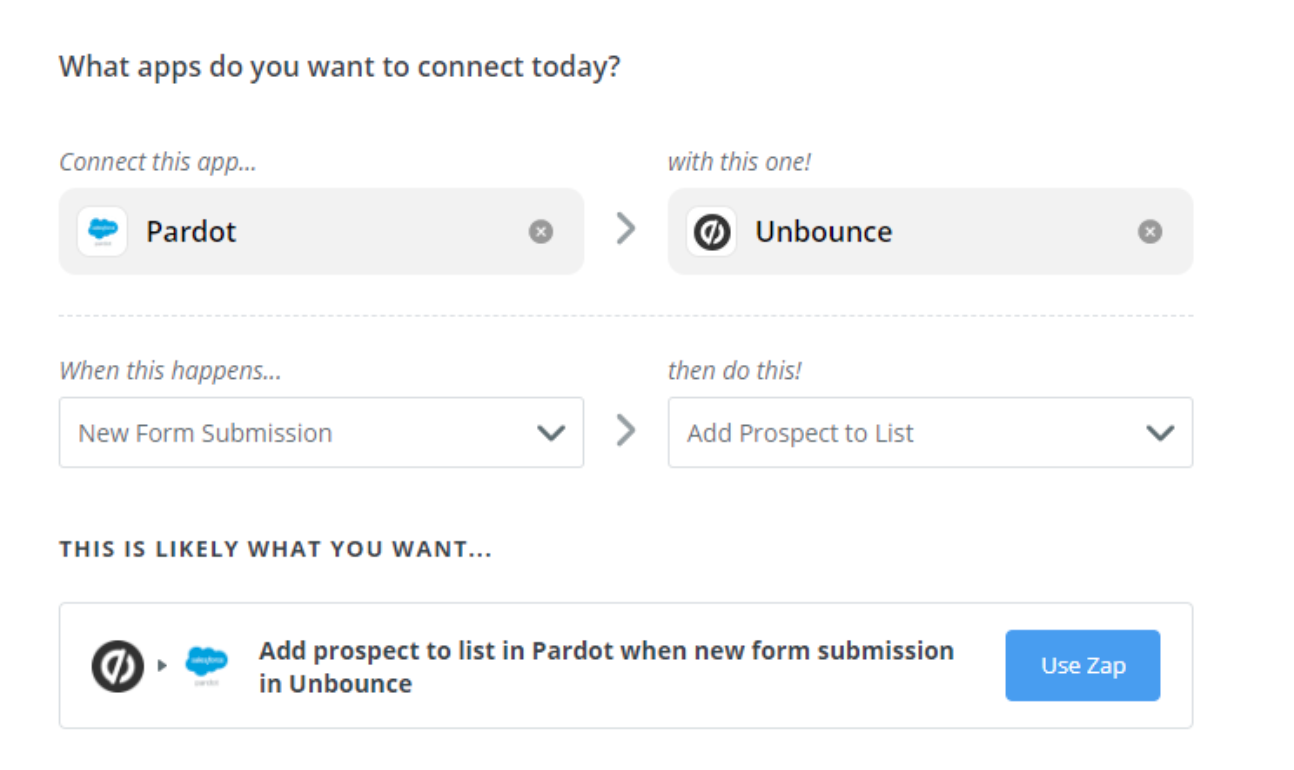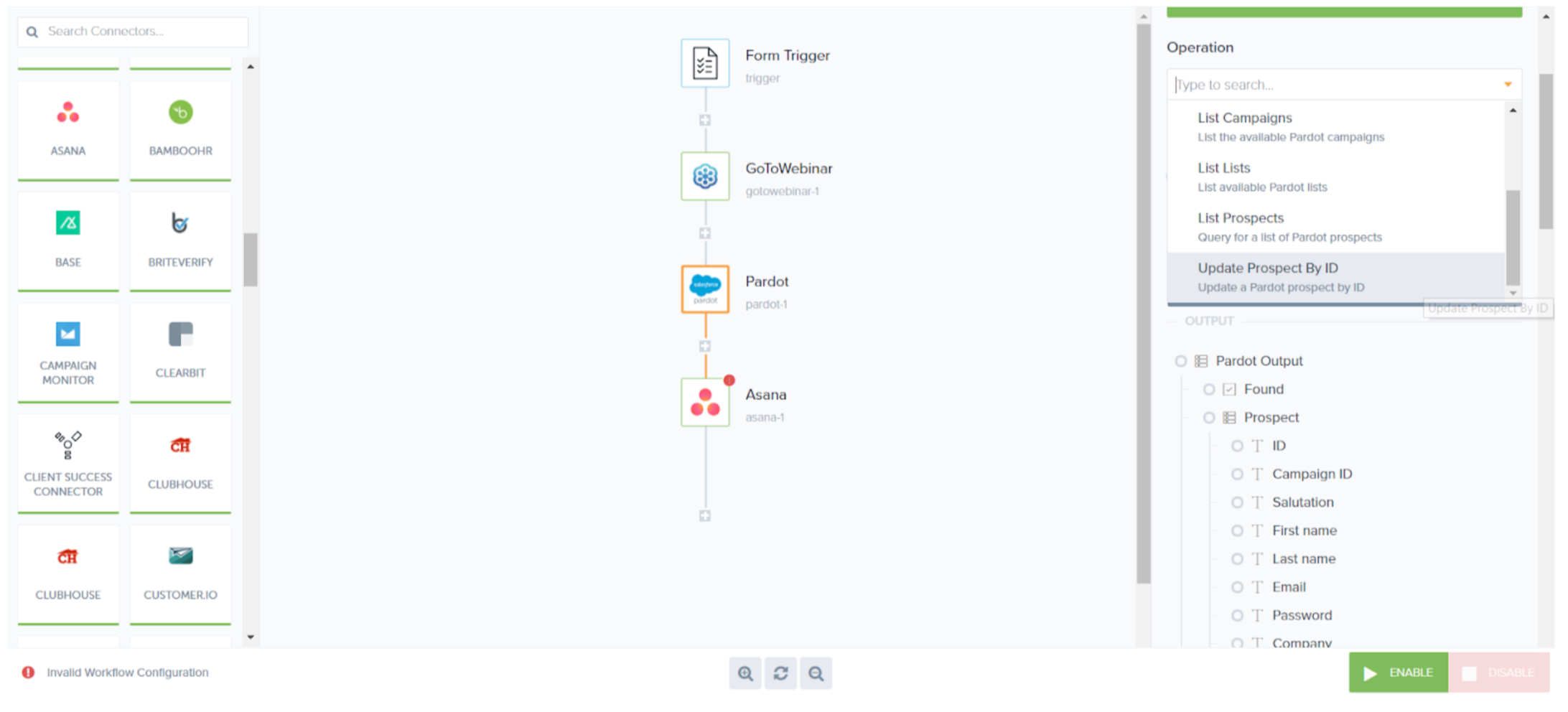Connectors vs. Custom Integrations – What’s Right for Your Salesforce Marketing Stack?
- March 13, 2023
- Connectors, Salesforce Ben | The Drip
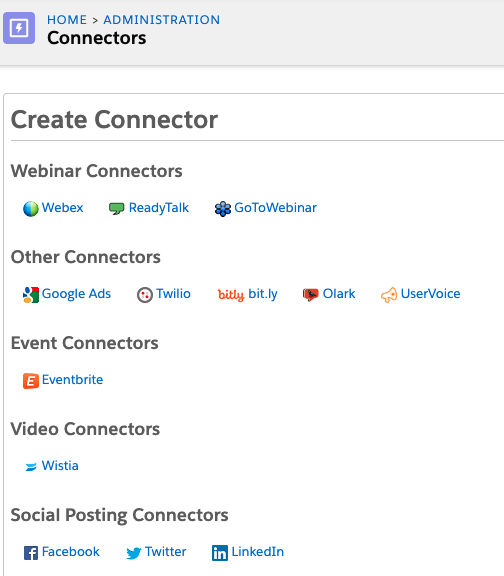

Pardot (Account Engagement) offers connectors that integrate third-party platforms with your core marketing automation database and processes. These ‘plug in and play’ integrations are ready to use within a few clicks.
The reality is that every organization is different. You may find that these connectors are not adaptable enough to cater to your system, including which data points are passed from one system to the other, the format data ends up in Pardot (Account Engagement), and the frequency in which syncs happen.
We all want to get more mileage out of the tech stack we have at our disposal – this is one of the foundations of a well-oiled marketing ops machine. As one of the core aspects of marketing ops is to take advantage of all the data collected while eliminating manual processes, establishing proper integrations is key.
This guide will detail four options for integrating Pardot (Account Engagement) with third-party systems. The options are ordered from least to most development overhead. First, let’s cover the considerations you should make when using the native connectors.
Pardot Native Connectors Considerations
Pardot (Account Engagement) offers connectors that integrate third-party platforms with your core marketing automation database and processes. With an administrator role, you will find these under: Account Engagement Settings → Connectors.
While integrations are ready to use within a few clicks, the customization options are minimal. The following are considerations to make while choosing whether to use a native connector or to explore custom integrations:
Limited applications
Firstly (and the most obvious of all) there’s not a connector for every application that you could ever want to use. The connectors offered in Pardot (Account Engagement) are shown in the image below. For example, in terms of webinar connectors, you only have GoToWebinar.
Note: The ReadyTalk, AKA ‘GlobalMeet’ connector and WebEx connector has been retired.


Selective data points
The data points that are passed from one system to the other, are determined by the connector. There may be other data points that you’d like to sync to Pardot (Account Engagement), however, it’s not possible to ‘go under the hood’ to fully amend the connector’s data mappings.
Data format
The format data ends up in Pardot (Account Engagement) is important. Is the syncing data mapped to fields? (Field data can be used in automation and segmentation) Or, is synced data read-only? While Pardot (Account Engagement) offers minimal reporting capabilities beyond the WYSIWYG reports, field data can be synced to Salesforce, which can be utilized in Salesforce reports, or datasets for B2B Marketing Analytics. The Google Ads connector is a prime example of how data format impacts the usability of synced data.
Sync frequency
How often syncs happen determines the reliability of the data ‘picture’ you see in Pardot (Account Engagement). Connectors will come with a pre-set frequency, and a bandwidth (i.e. the volume of records that can be processed at once, known as ‘batching’). Depending on how ‘real-time’ your marketing automation needs to be, or the number of records you are looking to update, this predetermined sync may not be sufficient.
What’s the big deal? While connectors will cater to some organizations without any problems, others will consider their limitations as hurdles. If data doesn’t end up in the right place, at the right time, the disadvantages range from merely an inconvenience, through to stifling your automation efforts, or your organization sending out inaccurate communication.
Option 1: Form Handlers
Some solutions involve form handlers, where a form submission, either by the prospect or the system, sends data to Pardot (Account Engagement) and another system, simultaneously. Note that this submission could be hidden to the user, e.g. or behind a button/link.
LinkedIn Event registrations to GoToWebinar is a use case that illustrates this:
Disadvantages:
- You are limited to syncing field data to Pardot (Account Engagement), i.e. not able to create prospect activities/Engagement History records.
- Troubleshooting: During setup and any additional amendments, you will need to test the form handler multiple times. Continue monitoring is required, as you will not be warned if there are errors.
Option 2: Marketing App Extensions
Marketing App Extensions are where you connect Pardot (Account Engagement) to external platforms, using the Pardot API. They are a step up from both native connectors and integrations via form handlers because moments of engagement in external systems are created in Pardot (Account Engagement) as activities.
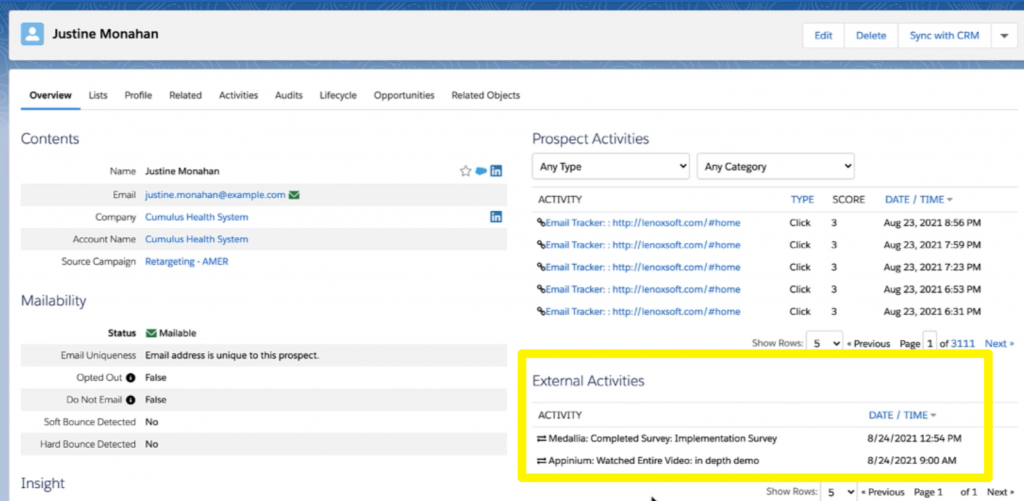

Setting up a Marketing App Extension for each external app enables you to create an External Activity Type. You can have multiple Activity Types per Marketing App Extension – for example, engagement data from a survey app could be “Survey completed” or “Survey abandoned”.
These recorded activities can be used across Pardot (Account Engagement):
- Dynamic lists.
- Automation rules.
- Segmentation rules.
- Engagement Studio: Trigger and rule steps can be based on External Activities. Note: Action steps can be based on External Actions.
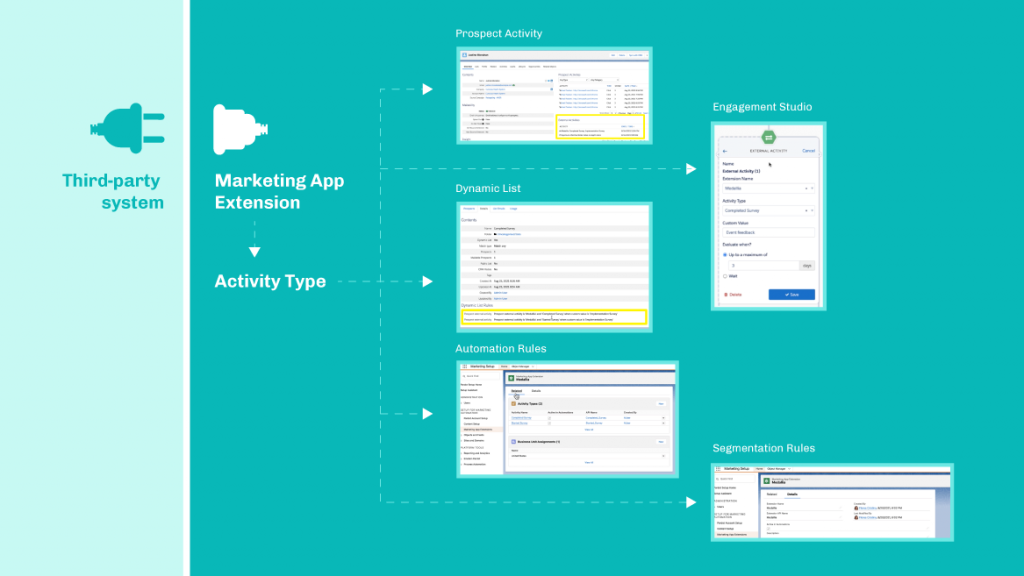

Setting up both External Activities and External Actions require support from a developer to create what’s called invocable actions. However, the good news is that once they’re created, you won’t need to amend them providing the syncing data points and behavior doesn’t need to change.
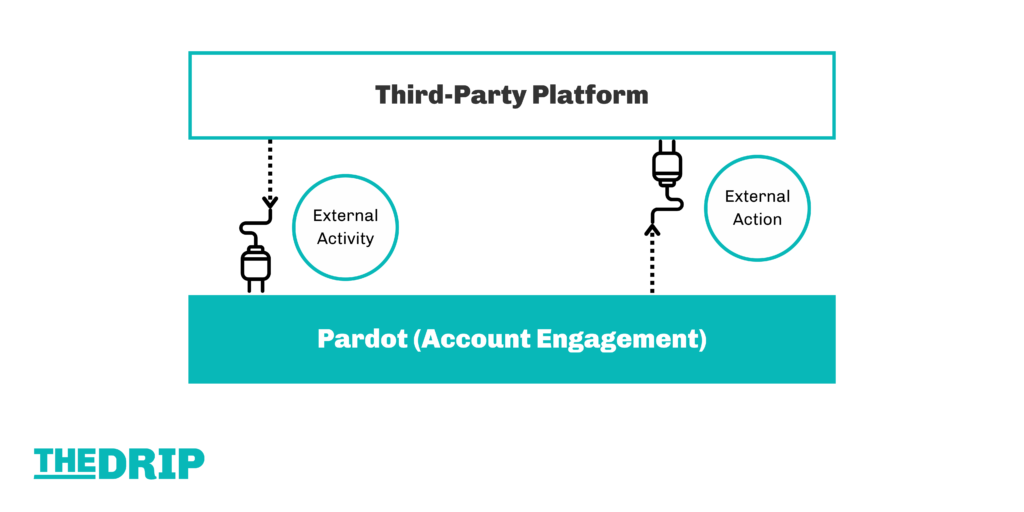

With External Actions, you can monitor:
- External Actions Usage: A table to review all third-party app usage Navigate to: Pardot Settings → Account Settings → Usage and Limits sub-tab.
- External Action Errors: A table to identify issues with External Action automations, steps, and actions. Navigate to: Pardot Settings → External Action Errors.
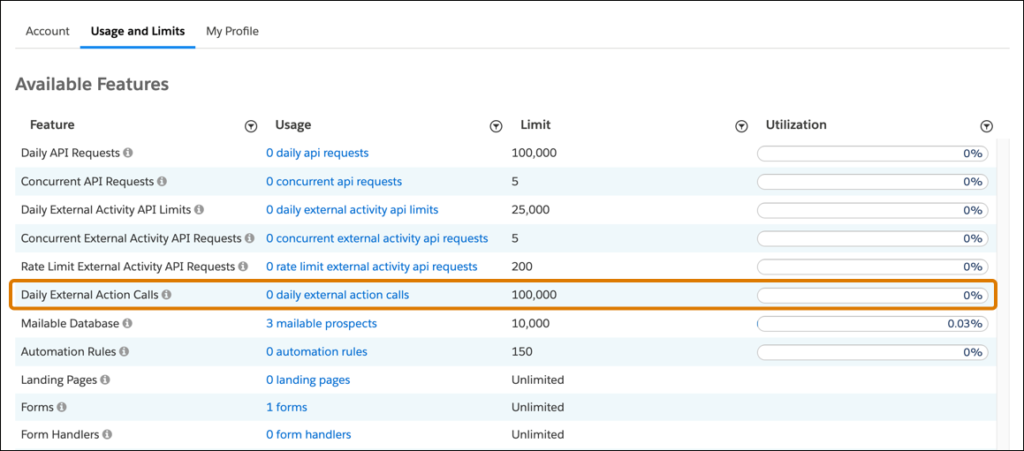



Option 3: Microservices
Microservices further improve how marketers coordinate the elements (data sources, content, workflows) of their situation (teams, channels) to produce the desired effect (single profile of an individual, actionable engagement data) – and be able to add elements without disrupting their situation.
Microservices are like the ‘middle man’ between the third-party platform and Pardot (Account Engagement). As paid services themselves, they come with further benefits; the main benefit is that configuring integrations can all be done with clicks, in a nice visual interface.
Another advantage is that you can monitor jobs, in other words, the actions triggered and whether they were successful.
Option 4: Custom Integration
Finally, the Pardot (Account Engagement) integration option with the most flexibility, yet the most development overhead: The Pardot API.
Over the years, the Pardot API has been improved with every release. For example, the ability to query more Pardot objects, and offering more endpoints for integrated systems to send data to.
With great power, comes greater responsibility. To leverage the Pardot API, you will need someone on board who has a developer skill set, and ideally, who is proficient in the Pardot API (as it has changed so frequently).
You will also need to take your account’s API limits into consideration. Pardot (Account Engagement) editions are based on the number of API calls overall i.e. the number of times Pardot ‘speaks’ to a third-party integration, and vice versa.
With Advanced edition, you gain increased API call limits. Additional API calls are available to purchase on other editions. However, a trade-off applies here; purchasing a lower edition of Pardot (Account Engagement) and then adding on API calls can become expensive just for the sake of a short term fix.
| Growth | Plus | Advanced | Premium | |
|---|---|---|---|---|
| External Activity Active Extensions | 0 | 10 | 20 | 30 |
| External Activity API | 0 | 50,000 | 100,000 | 100,000 |
| API Access — Calls per day | 25,000 | 50,000 | 100,000 | 100,000 |
Summary
This guide has detailed the differences between native connectors and custom integrations between Pardot (Account Engagement) and your wider marketing tech stack.
- Native connectors are pre-built and easy to use, but they may not be flexible enough to cater to specific needs.
- Custom integrations require more development work, but they provide greater customization options.
Now you know about the considerations to make when choosing between native connectors form handlers, Marketing App Extensions, and custom integrations. When evaluating, consider the data points required, the format data ends up in Pardot (Account Engagement), and how often the sync occurs.
This Pardot article written by:
Salesforce Ben | The Drip
Lucy Mazalon is the Head Editor & Operations Director at Salesforceben.com, Founder of THE DRIP and Salesforce Marketing Champion 2020.
Original Pardot Article: https://www.salesforceben.com/the-drip/connectors-vs-custom-integrations-whats-right-for-your-salesforce-marketing-stack/
Find more great Pardot articles at www.salesforceben.com/the-drip/
Pardot Experts Blog
We have categorized all the different Pardot articles by topics.
Pardot Topic Categories
- Account Based Marketing (ABM) (8)
- Business Units (13)
- ChatGPT / AI (3)
- Completion Actions (5)
- Connectors (10)
- Custom Redirects (4)
- Demand Generation (8)
- Dynamic Content (5)
- Einstein Features (11)
- Email Delivery (18)
- Email Open Rates (3)
- Pardot A/B Testing (2)
- Email Mailability (16)
- Do Not Email (1)
- Double Opt-in (2)
- Opt Out / Unsubscribe (14)
- Email Preferences Page (6)
- Engagement Studio (14)
- Industries (1)
- Non Profit (1)
- Landing Pages (10)
- Lead Generation (1)
- Lead Management (12)
- Lead Routing (2)
- Lead Scoring (15)
- Leads (3)
- Marketing Analytics – B2BMA (9)
- Marketing Automation (1)
- Marketing Cloud (2)
- Marketing Cloud Account Engagement (4)
- New Pardot Features (6)
- Opportunities (2)
- Optimization (3)
- Pardot Admin (62)
- Duplicates (1)
- Marketing Ops (1)
- Pardot Alerts (1)
- Pardot API (2)
- Pardot Automations (3)
- Pardot Careers (12)
- Pardot Certifications (4)
- Pardot Consulting (1)
- Pardot Cookies (3)
- Pardot Custom Objects (3)
- Pardot Email Builder (7)
- Pardot Email Templates (9)
- HML (6)
- Pardot Events (16)
- Pardot External Actions (1)
- Pardot External Activities (4)
- Pardot Forms (27)
- Form Handlers (7)
- Pardot Integrations (21)
- Data Cloud (1)
- Slack (1)
- Pardot Lead Grading (5)
- Pardot Lead Source (2)
- Pardot Lightning (1)
- Pardot Migration (1)
- Pardot Nurture / Drip Campaigns (1)
- Pardot Personalization (3)
- Pardot Profiles (1)
- Pardot Releases (19)
- Pardot Sandboxes (2)
- Pardot Segmentation (4)
- Pardot Strategy (7)
- Pardot Sync (2)
- Pardot Sync Errors (1)
- Pardot Tracker Domains (5)
- Pardot Training (3)
- Pardot Vs Other MAPs (4)
- Pardot Website Tracking (2)
- Reporting (22)
- Salesforce and Pardot (29)
- Marketing Data Sharing (2)
- Pardot Users (3)
- Salesforce Automation (4)
- Salesforce Flows (1)
- Salesforce Campaigns (20)
- Salesforce CRM (3)
- Record Types (1)
- Salesforce Engage (3)
- Salesforce Queues (2)
- Security and Privacy (1)
- Tags (3)
- The Authors (483)
- Cheshire Impact (9)
- Greenkey Digital (47)
- Invado Solutions (37)
- Jenna Molby (9)
- Marcloud Consulting (6)
- Nebula Consulting (53)
- Pardot Geeks (38)
- Salesforce Ben | The Drip (235)
- SalesLabX (2)
- Slalom (2)
- Unfettered Marketing (45)
- Uncategorized (1)
- Website Tracking (2)
- Website Search (1)
More Pardot Articles
See all posts
This Pardot article written by:
Salesforce Ben | The Drip
Lucy Mazalon is the Head Editor & Operations Director at Salesforceben.com, Founder of THE DRIP and Salesforce Marketing Champion 2020.
Original Pardot Article: https://www.salesforceben.com/the-drip/connectors-vs-custom-integrations-whats-right-for-your-salesforce-marketing-stack/
Find more great Pardot articles at www.salesforceben.com/the-drip/

